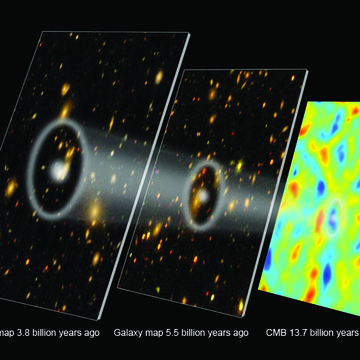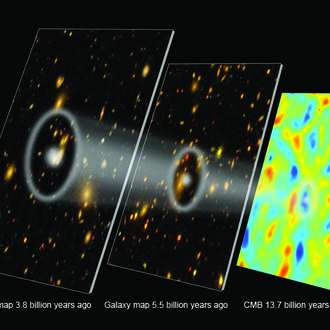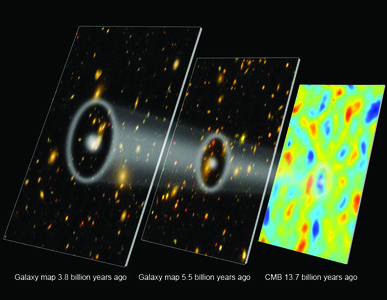When Dark Energy turned on

The record of baryon acoustic oscillations helps astronomers to retrace the history of the expanding universe.
Credit: E.M. Huff, the SDSS-III team, and the South Pole Telescope team. Graphic by Zosia Rostomian.The Sloan Digital Sky Survey (SDSS-III) today announced the most accurate measurements yet of the distances to galaxies in the faraway universe, giving an unprecedented look at the time when the universe first began to accelerate. From different perspectives six publications, which have been published online now, address the question of “Dark Energy“, the unknown force that drives our Universe apart.
Full text of the press release by the SDSS collaboration, including high-resolution image: http://www.sdss3.org/press/20120330.bspec.php
Sebastian Nuza of the Leibniz Institute for Astrophysics Potsdam (AIP) is among the co-authors. His specialization are numerical simulations of cosmological structure formation and predictions of the clustering of galaxies. All published results together allow for the most complete view of the distant Universe and are an important step towards understanding what drives its expansion.
About SDSS-III
Funding for SDSS-III has been provided by the Alfred P. Sloan Foundation, the Participating Institutions, the National Science Foundation, and the U.S. Department of Energy Office of Science. The SDSS-III web site is www.sdss3.org. SDSS-III is managed by the Astrophysical Research Consortium for the Participating Institutions of the SDSS-III Collaboration including the University of Arizona, the Brazilian Participation Group, Brookhaven National Laboratory, University of Cambridge, Carnegie Mellon University, University of Florida, the French Participation Group, the German Participation Group, Harvard University, the Instituto de Astrofisica de Canarias, the Michigan State/Notre Dame/JINA Participation Group, Johns Hopkins University, Lawrence Berkeley National Laboratory, Max Planck Institute for Astrophysics, Max Planck Institute for Extraterrestrial Physics, New Mexico State University, New York University, Ohio State University, Pennsylvania State University, University of Portsmouth, Princeton University, the Spanish Participation Group, University of Tokyo, University of Utah, Vanderbilt University, University of Virginia, University of Washington, and Yale University.
Further information
All six publications have been posted online today at astro.ph: http://arxiv.org
Previously posted publication by Sebastian Nuza about the clustering of galaxies

The record of baryon acoustic oscillations helps astronomers to retrace the history of the expanding universe.
Credit: E.M. Huff, the SDSS-III team, and the South Pole Telescope team. Graphic by Zosia Rostomian.The Sloan Digital Sky Survey (SDSS-III) today announced the most accurate measurements yet of the distances to galaxies in the faraway universe, giving an unprecedented look at the time when the universe first began to accelerate. From different perspectives six publications, which have been published online now, address the question of “Dark Energy“, the unknown force that drives our Universe apart.
Full text of the press release by the SDSS collaboration, including high-resolution image: http://www.sdss3.org/press/20120330.bspec.php
Sebastian Nuza of the Leibniz Institute for Astrophysics Potsdam (AIP) is among the co-authors. His specialization are numerical simulations of cosmological structure formation and predictions of the clustering of galaxies. All published results together allow for the most complete view of the distant Universe and are an important step towards understanding what drives its expansion.
About SDSS-III
Funding for SDSS-III has been provided by the Alfred P. Sloan Foundation, the Participating Institutions, the National Science Foundation, and the U.S. Department of Energy Office of Science. The SDSS-III web site is www.sdss3.org. SDSS-III is managed by the Astrophysical Research Consortium for the Participating Institutions of the SDSS-III Collaboration including the University of Arizona, the Brazilian Participation Group, Brookhaven National Laboratory, University of Cambridge, Carnegie Mellon University, University of Florida, the French Participation Group, the German Participation Group, Harvard University, the Instituto de Astrofisica de Canarias, the Michigan State/Notre Dame/JINA Participation Group, Johns Hopkins University, Lawrence Berkeley National Laboratory, Max Planck Institute for Astrophysics, Max Planck Institute for Extraterrestrial Physics, New Mexico State University, New York University, Ohio State University, Pennsylvania State University, University of Portsmouth, Princeton University, the Spanish Participation Group, University of Tokyo, University of Utah, Vanderbilt University, University of Virginia, University of Washington, and Yale University.
Further information
All six publications have been posted online today at astro.ph: http://arxiv.org
Previously posted publication by Sebastian Nuza about the clustering of galaxies
Images
The record of baryon acoustic oscillations helps astronomers to retrace the history of the expanding universe.



